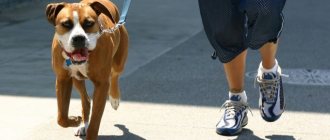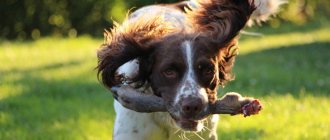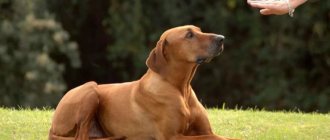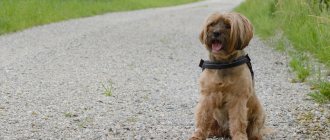Every dog breeder in the first year of a puppy’s life thinks: “How to teach a dog the fetch command from scratch at home?” And this is no coincidence. After all, this skill is considered one of the most important for a dog and is part of the mandatory training complex.
This team is considered one of the most difficult. However, every animal can master it. To achieve success in this matter, the trainer only needs to follow the general rules of working with an animal and regularly perform the necessary training until the skill is fully consolidated.
What does the command fetch a dog mean?
Fetch is one of the main commands that a trained pet must perform. Its name comes from the French word apporter, which means “to bring.” The aport command consists of several elements. It works like this:
- Initially, the dog takes a position near the left leg of its owner at the command: “Sit.”
- After this, the person shows the dog the object that it must bring (a stick, a ball) and throws it forward 10 meters or more.
- 10-15 seconds after the throw, the owner of the animal gives him the command: “Fetch.” At the same time, he extends his right hand towards the thrown object, palm down.
- After this, the dog goes for a ball or stick, finds it, takes it in its mouth, then brings it to the owner and sits near his left leg.
- After 10-15 seconds, the owner gives her the following order: “Give,” after which the animal must give the object to the trainer.
There are a number of requirements for executing the presented command. They provide:
- The animal's calm attitude towards the training object. It should not show excessive aggression towards it, try to chew or tear it.
- Strict execution of orders as directed by the owner. The pet should not rush after the ball before its owner commands it.
In addition, when executing the “Fetch” command, the dog must obediently wait until the object is taken from its mouth. Otherwise, the trick will not be counted.
Aport is traditionally included in the UEC. Although this command is considered difficult, most animals master it quite easily and quickly.
A little theory
Training a dog is a long process, the goal of which is to form a conditioned reflex to a specific stimulus. In this case, several will act as this:
- voice command “Aport”;
- gesture (throwing the thrown object with the right hand);
- teasing (swinging things in front of the animal's eyes);
- delicacy;
- encouraging affection.
If training is carried out with an adult dog, then the study of “fetch” begins only after the commands “come to me” and “sit” have been worked out.
What is the best item to use for training?
In order for the training of a German Shepherd or any other breed to be successful, you should pay special attention to the object used during training. It must meet the following requirements:
- Easy to disinfect. It should be washed after every workout.
- Be attractive to your pet. Otherwise he won't run after him.
- Have a smooth surface. Dogs are reluctant to take fluffy objects into their teeth, so they are not suitable for training.
Also, a thing used to practice the fetch command with a husky or any other breed of dog must be moderately strong, durable and safe for the animal. Use for training only those items that are made from natural materials, do not injure the animal’s mouth, and do not contain harmful dyes.
You can use the following items for training: tennis balls, plastic bottles with sand, frisbees, special sticks that are sold in pet stores. If you don't have such things on hand, you can use a regular stick found on the street for training.
Best time to practice
It is important that during training the dog is not too full and not too hungry. That is, at least 2 hours must pass after eating. The animal should not be sleepy and tired, otherwise it is unlikely to bring the owner a ball or any other thing. Of course, you should not train a pet that is not feeling well (poor appetite, weakness, digestive disorders, high fever, etc.).
In addition, what the animal’s mood is is of great importance. If your pet is angry, sad or overly excited, it is better to postpone training for a while. By the way, not only the attitude of the dog itself is important, but also that of its owner. You should not start training if your heart is not right. A bad mood will certainly be transmitted from a person to an animal.
Is it possible to train an adult dog from scratch?
Adults are less trainable than puppies. However, they can also be taught the "Fetch" command. To achieve success in this matter, it is important to choose an object that will attract the animal and work with it daily for several weeks using the same method as with puppies.
It is not practical to train this command only to adults who are engaged in official work, including demining, rescue and search operations. It is enough to teach them the commands “Sit”, “Nearby”.
Teaching methods
Professional trainers know at least a dozen training options for each individual skill. The average owner does not need such deep knowledge; it is enough to consider the most popular and effective ways of teaching a dog the “down” command. The methods listed below are suitable for pets of any age, breed and psychological state.
Pointing method
The most common and simplest method of teaching the “down” command. Equally suitable for the smallest puppies and older dogs. It does not cause discomfort to the animal, when repeated regularly it gives good results and helps to establish contact with the owner.
Training program:
- Starting position – the dog sits in front of the trainer;
- The trainer has motivation in his hand (a piece of treat or a favorite toy);
- A fist with a motivational object is brought to the pet’s very nose, wait until the dog is interested in the thing in the hand;
- Slowly, move the hand with the treat down from the dog’s nose and slightly away from it;
- When it is already clear that the dog is about to lie down, they give the command “lie down”;
- After performance, they give motivation - a treat or a toy;
- Finish the exercise with the command “walk”.
It is very important that the dog receives the reward while lying down, otherwise it is not the execution of the order that is reinforced, but the cessation of the desired action. To increase food motivation, training is carried out with a hungry dog - before eating, or skipping one feeding
Method of coercion
The coercion method is not suitable for timid, unconfident dogs, and is also not recommended for very small puppies. The method is based on forcibly forcing the animal into a lying position. You can use any variation of the effect:
- Using a leash attached to the collar. They simply pull the leash down, causing the dog discomfort, which can only be avoided by lying down.
- A variation of “sculpting” if the pet does not resist. The dog is laid down using the hands (from a sitting position, taken by the paws and brought to a horizontal position).
- Press firmly on the withers when the dog is sitting. Painful sensations will force the animal to lie down.
It is very important to maintain a reasonable amount of force so as not to injure or intimidate the dog. Otherwise, the predator, at the level of the instinct of self-preservation, may go into a defensive position or begin to run away (depending on the characteristics of the psyche or breed)
Behavior selection method
A very simple method, but it is used quite rarely, because when using it, the owner will have to be patient. Suitable for all breeds and ages, but training takes a long time.
The essence of the behavior selection method is simple:
- The owner “catch” moments when the dog is in a horizontal position;
- Gives the command “lie down”;
- Encourages in any convenient way.
Way to imitate
The imitation method is used in group classes, in the presence of an adult trained individual. Great for young dogs up to one year old.
The essence of the training system is based on competition. The instructor gives the command to the trained pet to “lie down”; after completing the task, the adult dog is actively praised and treated with a treat. At this moment the puppy is in a free position; as a rule, the desire to also get a piece of “yummy” motivates the young animal to repeat the action after its older relative.
How to teach a puppy the fetch command?
It is important to prepare properly for training. To do this you need:
- Choose a suitable place to study. You can train with your pet at home or outdoors. The main thing is that there is nothing on the site you choose that distracts the puppy from performing the exercise.
- Think about how you will reward the dog for correctly following the command. You can please your pet with a treat, verbal praise, or petting. This will give him the motivation he needs to study.
- Prepare the necessary equipment. In addition to the training item, you will also need a collar with a leash and gloves.
To teach how to fetch something, you should work with your pet like this:
- The dog needs to be seated near your left leg. You should hold the leash in your left hand.
- You should take the fetch item in your right hand and show it to the dog. As soon as the animal wants to take it, you need to say the word “Fetch” and allow the pet to grab this thing. If the animal copes with this task, it must be praised to reinforce the skill. If the dog holds the retrieval object too weakly, you need to pull it - as soon as the dog understands that the thing is being taken away, he will strengthen his grip.
- Then the dog must be commanded “Give.” She must return the training item immediately. After this, the pet needs to be rewarded by offering him a treat.
If for some reason your pet refuses to take a stick or ball between its teeth, try putting the thing in its mouth and applying a little pressure to its jaw. Be sure to praise your pet afterwards. Repeat this trick several times, and the dog will begin to show interest in the fetch item. At the first stage of training, this is quite enough.
Once your dog learns to take an object in its teeth and give it back at the owner’s request, you can move on to the next stage of training. You need to teach your pet to move with an object in its teeth. To do this, you need to give the thing teeth to the animal by commanding “Fetch”, then give the command “Nearby”, take 6 steps with him and take the ball or stick from him using the order “Give”.
The next step is to teach the dog to pick up an object from the ground. Do it like this:
- Place the dog on the ground.
- Sit down next to her.
- Show me the thing.
- Throw a short distance and command: “Aport.”
- Then go up to the thrown object and again order: “Fetch.”
- Wait for the dog to pick it up.
- After this, walk with the animal a few steps and order the product to be given back.
When the puppy begins to confidently take the thing from the ground, begin to pause between the throw and the “Fetch” command itself. Then let your dog go after the object on a leash, but do not go after it yourself. Gradually cancel the intermediate orders “Sit”, “Give”, “Next”. As soon as the dog begins to fully execute the “Fetch” command on its own, move on to more complex variations of it.
Teach your pet to complete a given task at a certain time, use different objects for training, teach your dog to look for a ball, stick or bottle among other things lying on the ground.
Video: how to teach a dog the fetch command from scratch at home?
The final stage
When the dog has learned the exercise well, send it to get the object while you stay behind it. When the dog takes the object, say “To me” and then “Nearby”. Wait until the dog sits to your left and take the item. Now praise her and encourage her.
The dog comes, sits and gives the item on command
Gradually cancel the intermediate commands “Come to me”, “Nearby”, the dog must correctly do the entire set of exercises according to one command - “Fetch”.
Actionable tips
Teaching a puppy the “Fetch” command is not as difficult as it might seem at first glance. To cope with this task quickly and easily, follow these rules:
- Before you start training the “Fetch” command, you need to practice the skills “Give”, “Nearby”, “Sit”, “Come to me” with the animal.
- Do your workouts daily. Repeat each exercise 3-4 times, after which be sure to take short breaks of up to 10 minutes so that your pet does not lose interest in the exercises.
- Practice for at least an hour. Continue practicing the skill even if the animal begins to lose interest in the exercise. Let it understand that the owner’s order must be carried out regardless of whether you want to do it or not.
- Proceed to the next stage of training only when you have fully mastered the previous one. If your pet is not confident in performing any part of the command, devote more time to practicing this skill.
- If, when executing the “Nearby” order, the pet spits a ball or stick out of its mouth, you need to give it an object in its teeth and silently walk next to it. Do this several times and the dog will begin to correctly obey the “Near” order, even if you don’t say it.
- Use a leash in the first stages of training. Only after the animal has learned to perform fetch well, start training without a leash.
- Give all orders in a calm, firm tone. Don't raise your voice at your dog, even if it does something wrong.
- Make sure that the dog does not get too carried away with the training object. If he starts playing with it, wait 3-5 minutes until the animal calms down, and then hide the object for 2-3 minutes. After this, the pet will be able to continue training at its usual rhythm.
- Do not show the treat to the dog before the start of the lesson. Otherwise, he will not run after a ball or stick, but will simply sit and wait for a treat. It is best to hide the treat in your pocket or bag so that the animal cannot detect it.
- In between performing commands, be sure to play with your pet and praise it. This will keep him interested in training. It is especially important to do this if you are working with an animal of choleric temperament.
- Practice the command with various objects, conduct training in different places. This will allow the dog to carry out a similar order in the future, regardless of the situation.
- If something doesn’t work out for you during the training process, do not show aggression towards the animal under any circumstances. Remember that you cannot hit the dog or raise your voice at it. You need to control your pet's behavior by pulling on the leash or pressing your hand.
If long-term training with a puppy does not produce results, it is better to seek help from a trainer. He will be able to teach the dog this command in a short time.
Passive inflection method
This method involves physical impact on the animal. The owner puts an object into the pet’s mouth with his hand and holds it for a certain time, while commanding “Aport.” If everything goes well, the dog receives a treat.
However, this method is not comfortable for the animal; the dog may become aggressive. With such training, the pet does not receive any development, and its attention is concentrated on the trainer, and not on the lessons. Therefore, it is best to conduct classes using the traditional method.
It is necessary to explain to the dog exactly what is required of it.
Possible errors during operation
Training does not tolerate mistakes, which are often made by inexperienced trainers. To avoid failure in the learning process, you need to know what not to do:
- allowing you to play with the brought thing for a long time - this destroys discipline and kills obedience;
- move too quickly to the tray from a distance - in the future this will significantly complicate the execution of the “Fetch” command and movement with the object;
- You cannot hold a treat in your hand when the animal is standing with the item in its mouth - this could cause it to spit out the item before the allotted time.
Sources
- https://www.vetkursk.ru/kak-priuchit/kak-nauchit-sobaku-komande-aport-chto-znachit-algoritm-obucheniya.html
- https://zen.yandex.ru/media/id/5e0f5c2f98930900b3abb8dd/kak-nauchit-sobaku-komande-aport-5eaa78179fff8e37dacb09d8
- https://BogardClub.ru/dressirovka/aport-sobake.html
- https://DogBuldog.ru/sobaki/dressirovka/kak-nauchit-komande-aport-5332/
- https://vplate.ru/sobaki/komanda-aport/
- https://sobachulki.ru/vospitanie/dressirovka/chto-oznachaet-komanda-aport-dlya-sobaki-instruktsiya-po-obucheniyu-zhivotnogo
- https://pet-master.ru/kak-soderzhat/aport-komanda.html
- https://yarus-spb.ru/sobaki/kinologiya/komanda-aport.html
- https://aquatech-spb.ru/dressirovka/apport-dlya-sobak.html
- https://dogworry.ru/dressirovka/kak-nauchit-sobaku-komande-aport-s-nulya.html
- https://gafki.ru/sobaki/aport-komanda-chto-znachit.html
Ew or Not
This command is prohibitive. The purpose of its implementation is to stop unwanted behavior: damaging things, eating prohibited food, picking up garbage, and so on. Achieving precise implementation is not easy. There are many ways to learn.
You need to teach your pet the Fu or Don't exercise as early as possible. Puppies explore the world with the help of their teeth, so it is in your best interest to get the command executed as early as possible.
The Fu command is not rewarded with treats and should only be used in a substantive manner.
How to teach a dog the command Fu, No?
One of the popular methods is to provoke him to pick him up from the ground and jerk the leash. Prepare pieces of sausage, sausages or other food in advance and scatter it around the walking area. When your furry friend reaches for a treat, sharply pull back the leash and loudly say Fu or No. Don't reward your pet. Move on. To relax and distract your dog, say another command, such as Sit or Near, and praise him for doing so. Detailed video instructions on how to wean a dog from picking up from the ground are presented below.
During training, your task is to form unpleasant associations when pronouncing Fu, You Can’t. You can use an electric collar, a dog collar, or a rolled-up newspaper. Punish your puppy for doing it.
Another way to teach a dog the “No” trick is to “bite” the puppy on the withers. In this case, we act as if a puppy were being punished by its mother. This method is quite effective; the puppy quickly understands the essence. Detailed instructions are shown in the video.
It’s better to teach a puppy the prohibitions than to be afraid of having your expensive shoes taken away from an adult dog weighing 30-40 kg. The pet must clearly understand the consequences of the “No” command.
Skill Development
When the animal has learned to take an object on command, it is time to begin further development of the skill - bringing equipment from a distance.
- the dog is tied on a long leash;
- attract the animal's attention with a thing;
- throw it forward;
- shout out a command;
- when the animal grabs the toy, it is called;
- on the command “Give” the item is taken away;
- give out incentives.
A leash is necessary to yank the pet, after saying “Give”, in case it refuses to come back.
In the future, the work, if necessary at all, becomes more and more complicated:
- they are taught to walk around the trainer from behind and sit down near the left leg;
- they practice endurance “sitting” before sending the animal for the object being aported;
- they teach you to serve a variety of things, and not just one;
- training to find an object thrown into dense bushes, simply hidden somewhere.
Tracking
At the very beginning, the stick is thrown just a couple of meters from the bottom up. It is not recommended to throw over long distances until the dog has established a logical connection with the object.
If at first the pet walks around the stick, the trainer should lead him on a leash and point to it.
After the dog picks up the object, it should be praised and treated with a treat.
Why is the skill useful?
So that from the first days the puppy understands who is the boss in the house and does not begin to dominate the person by dictating his own rules, it is important to immediately begin training the pet.
Experts believe that teaching a dog to fetch things thrown into the distance is possible without the help of an experienced dog handler. Not everyone knows what the word “fetch” is for a dog. This is a skill that encourages the animal to run, pick up from the ground, return, walk around the owner on the right and sit on the left. Training is carried out with a puppy aged 7–8 months, who already knows and follows basic commands: “Come to me!”, “Near!” and “Sit!” The benefits of mastering the skill of bringing and giving an object to the owner are obvious: the dog gets used to looking for something and navigating in space, is involved in an interesting game process, using the organs of vision, hearing, smell and all types of its memory.
A conditioned reflex is also developed - the pet learns to build logical chains. Your pet must not only bring back what was thrown, but also learn to control his emotions and be patient, since the prey will have to be given back after the chase and search.
This skill will also allow a pet, whose owner, due to a busy work schedule, cannot walk with him for a long time, get the necessary physical activity.











